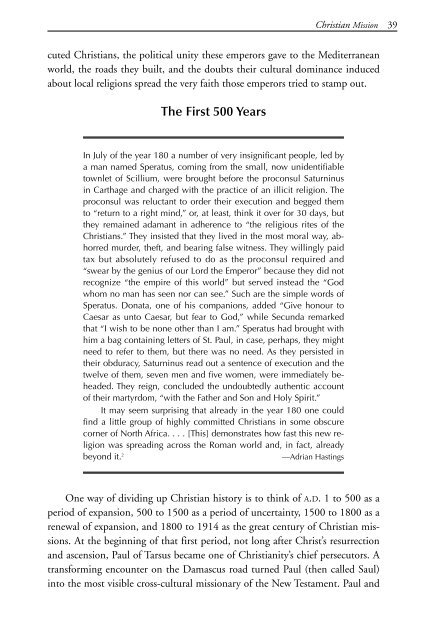discovering missions - Southern Nazarene University
discovering missions - Southern Nazarene University
discovering missions - Southern Nazarene University
Create successful ePaper yourself
Turn your PDF publications into a flip-book with our unique Google optimized e-Paper software.
245187 Disc Missions ins 9/6/07 1:04 PM Page 39<br />
cuted Christians, the political unity these emperors gave to the Mediterranean<br />
world, the roads they built, and the doubts their cultural dominance induced<br />
about local religions spread the very faith those emperors tried to stamp out.<br />
The First 500 Years<br />
In July of the year 180 a number of very insignificant people, led by<br />
a man named Speratus, coming from the small, now unidentifiable<br />
townlet of Scillium, were brought before the proconsul Saturninus<br />
in Carthage and charged with the practice of an illicit religion. The<br />
proconsul was reluctant to order their execution and begged them<br />
to “return to a right mind,” or, at least, think it over for 30 days, but<br />
they remained adamant in adherence to “the religious rites of the<br />
Christians.” They insisted that they lived in the most moral way, abhorred<br />
murder, theft, and bearing false witness. They willingly paid<br />
tax but absolutely refused to do as the proconsul required and<br />
“swear by the genius of our Lord the Emperor” because they did not<br />
recognize “the empire of this world” but served instead the “God<br />
whom no man has seen nor can see.” Such are the simple words of<br />
Speratus. Donata, one of his companions, added “Give honour to<br />
Caesar as unto Caesar, but fear to God,” while Secunda remarked<br />
that “I wish to be none other than I am.” Speratus had brought with<br />
him a bag containing letters of St. Paul, in case, perhaps, they might<br />
need to refer to them, but there was no need. As they persisted in<br />
their obduracy, Saturninus read out a sentence of execution and the<br />
twelve of them, seven men and five women, were immediately beheaded.<br />
They reign, concluded the undoubtedly authentic account<br />
of their martyrdom, “with the Father and Son and Holy Spirit.”<br />
It may seem surprising that already in the year 180 one could<br />
find a little group of highly committed Christians in some obscure<br />
corner of North Africa. . . . [This] demonstrates how fast this new religion<br />
was spreading across the Roman world and, in fact, already<br />
beyond it. 2 —Adrian Hastings<br />
Christian Mission 39<br />
One way of dividing up Christian history is to think of A.D. 1 to 500 as a<br />
period of expansion, 500 to 1500 as a period of uncertainty, 1500 to 1800 as a<br />
renewal of expansion, and 1800 to 1914 as the great century of Christian <strong>missions</strong>.<br />
At the beginning of that first period, not long after Christ’s resurrection<br />
and ascension, Paul of Tarsus became one of Christianity’s chief persecutors. A<br />
transforming encounter on the Damascus road turned Paul (then called Saul)<br />
into the most visible cross-cultural missionary of the New Testament. Paul and

















